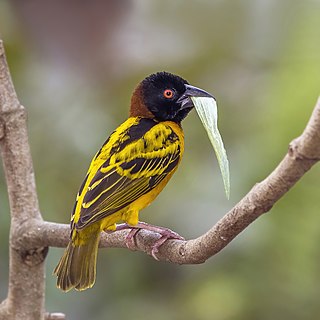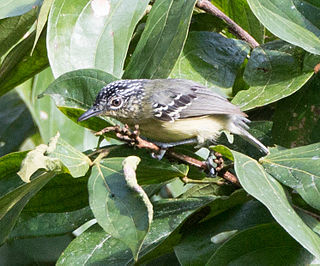
The alpine swift is a species of swift found in Africa, southern Europe, and Asia. They breed in mountains from southern Europe to the Himalayas. Like common swifts, they are migratory; the southern European population winters further south in southern Africa. They have very short legs which are used for clinging to vertical surfaces. Like most swifts, they never settle voluntarily on the ground, spending most of their lives in the air living on the insects they catch in their beaks.

The African palm swift is a small swift. It is very similar to the Asian palm swift, Cypsiurus balasiensis, and was formerly considered to be the same species. The Malagasy palm swift was also recently split from this species. This is a common species with a very wide distribution which faces no obvious threats and may be increasing in numbers as a result of the cultivation of the exotic Washington palm, so the International Union for Conservation of Nature has rated its conservation status as being of "least concern".

The village weaver , also known as the spotted-backed weaver or black-headed weaver, is a species of bird in the family Ploceidae found in much of sub-Saharan Africa. It has also been introduced to Portugal and Venezuela as well as to the islands of Hispaniola, Martinique, Puerto Rico, Mauritius and Réunion.

Mottled mannikin or mottled munia is a species of estrildid finch breeding in New Ireland. This species is also introduced to Pohnpei. It has an estimated global extent of occurrence of 20,000 to 50,000 km2. It is found in subtropical/ tropical (lowland) dry grassland habitat. The New Hanover mannikin has sometimes been treated as a subspecies of mottled mannikin with the name Hunstein's mannikin for the combined taxa. The status of mottled mannikin is evaluated as Least Concern. The males are similarly colored to the extinct Hawaiian ʻUla ʻAi Hāwane, a Hawaiian honeycreeper.

The brubru is a species of bushshrike found in most of Sub-Saharan Africa. It is the only member of the genus Nilaus.
Bates's swift is a species of small swift in the family Apodidae which is found in western Africa.
Sabine's spinetail is a species of swift in the family Apodidae. It is found in forests of Angola, Cameroon, Central African Republic, Republic of the Congo, Democratic Republic of the Congo, Ivory Coast, Equatorial Guinea, Gabon, Ghana, Guinea, Kenya, Liberia, Nigeria, Sierra Leone, Togo, and Uganda.

The scarce swift is a species of swift in the family Apodidae. It has a disjunct range of presence throughout the Afromontane : Cameroon line, Albertine Rift montane forests, Kenya, Tanzania, Malawi and Mozambique.

Tachymarptis is a genus of bird in the swift family, Apodidae. It contains the Alpine swift of Eurasia and Africa and the mottled swift of Africa. They are large swifts with relatively broad wings, a large head, a medium-length forked tail and white in the underparts. They are often included in the genus Apus but they are larger than other members of that genus, their nestlings have a different foot structure and they host different species of feather lice. The species placed in Tachymarptis are not deeply nested inside Apus but represent a monophyletic sister lineage to this genus, in order that they can either be regarded as a distinct genus or lumped into a genus Apus with a broader definition. This latter view is the one retained by the Clements Checklist (2022). The name Tachymarptis comes from Greek takhus ("fast") and marptis ("seizer").
The black spinetail is a species of swift in the family Apodidae. It is found in Angola, Cameroon, Central African Republic, Republic of the Congo, Democratic Republic of the Congo, Ivory Coast, Gabon, Ghana, Liberia, Nigeria, and Sierra Leone.

The mottled spinetail is a species of swift in the family Apodidae. It is found in Angola, Benin, Burkina Faso, Cameroon, Central African Republic, Republic of the Congo, Democratic Republic of the Congo, Ivory Coast, Equatorial Guinea, Gabon, Gambia, Ghana, Guinea, Guinea-Bissau, Kenya, Liberia, Malawi, Mali, Mozambique, Niger, Nigeria, Senegal, Sierra Leone, Somalia, South Africa, Tanzania, Togo, Uganda, Zambia, and Zimbabwe.

The yellow-breasted antwren is a species of bird in subfamily Thamnophilinae of family Thamnophilidae, the "typical antbirds". It is found in Colombia, Ecuador, and Peru.

The equatorial akalat is a species of bird in the family Muscicapidae. Its natural habitat is subtropical or tropical moist montane forests.

The blue-mantled crested flycatcher or African crested flycatcher is a species of bird in the family Monarchidae found in eastern and south-eastern Africa.

Trithemis pluvialis, the russet dropwing, is a species of dragonfly in the family Libellulidae. It occurs in Africa south of Kenya.

Bates's paradise flycatcher is a passerine bird belonging to the monarch-flycatcher family, Monarchidae. The sexes are similar in appearance with the upper parts being rufous and the head and underparts being bluish-grey. It is native to central Africa where it is found in the understorey of forests.

The Andean motmot or highland motmot is a colorful near-passerine bird found from northern Colombia to western Bolivia.

The Apodinae are a subfamily of swifts and contain the following species:
Jali Makawa was a Mozambique-born bird expert who assisted the British ornithologist C.W. "Con" Benson. He also worked with other ornithologists and collectors in east Africa including Melvin Traylor, Arthur Loveridge, Charles Sibley, and Michael Irwin. Makawa was famed for his observational skills, ability to identify novel species, mimic bird calls, collect, and prepare specimens. Several subspecies and a species of bird that he collected have been named after him.















